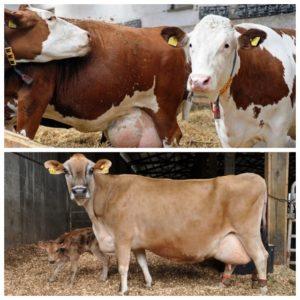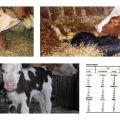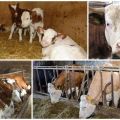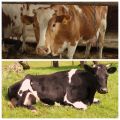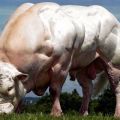How much water does a cow normally drink per day and the role of liquid, is it possible to cold
Cow's milk consists of fats, carbohydrates, minerals, vitamins and water. Moisture takes up more than 80% of the total milk composition. Burenka, which is sufficiently watered, shows high productivity. How much water a cow drinks per day is calculated based on many factors. With a lack of fluid, the pet gets sick. If the animal loses more than 20% moisture, it dies. It is necessary to provide free access to moisture so that the level of milk yield does not decrease.
The role of water in animals
An important element for the normal functioning of any mammal is water. Its composition in the body of any animal is about 60%. Cells, plasma, all tissues contain fluid. The main way of getting liquid into the cow's body is through food intake. The skin, muscles and connective tissue store water all day long.
Functions of water for mammals:
- Transportation. Water helps the beneficial trace elements and substances to be distributed throughout the body.
- Solvent. The liquid helps the body get rid of harmful substances.
- Normalization of the optimal oxygen level and pressure of the animal.
- Body temperature regulator.
With a lack of water in mammals, the following are observed:
- weakness;
- cardiopalmus;
- blood viscosity rises;
- body temperature increases;
- decreased appetite;
- metabolism is disturbed;
- the nervous system is excited;
- milk production drops.

How much water does a cow need per day
How much an animal drinks per day must be carefully controlled. To calculate the required amount, the following factors should be taken into account:
- general diet;
- ambient air temperature in the pasture and in the stable;
- moisture level;
- the physical condition of the animal;
- lactation phase.
The daily dose is 100-110 liters. The minimum quantity is 70 liters. If the cow eats dry food, then more liquid is needed. The calculation is as follows: 4-6 liters of water per 1 kilogram of dry food. Juicy herbs and vegetables reduce consumption, hot weather and active lactation increase.
The water must be clean and fresh. 24-hour access to drinking bowls helps the animal to independently regulate water exchange. If possible, the place of pasture of animals should be equipped with automatic drinkers. The cow should drink 3-4 times a day. Drinking water is regularly changed.
How to train an animal to drink cold water
Cows can drink liquid, the temperature of which is at least 10 degrees. The optimum drinking water temperature is 15-17 degrees. This saves the energy of the animals. It goes into milk production, not cold water heating.When drinking too cold water, cows have problems with the digestive system, the normal functioning of the stomach is disrupted. They refuse to drink, which is harmful to the body.
Features of drinking after calving
After calving, the cow needs plenty of warm drink to recuperate and start lactation. Burenka needs to be drunk 30-50 minutes after giving birth with warm salted water. Salt water is needed only after calving, in the future it can not be salted. The recommended water temperature is at least 25 degrees. To strengthen the body, it is recommended to prepare a chatterbox with special additives. A kilogram of wheat bran and 100 grams of salt are added to warm water, you can add a small amount of oat flour.
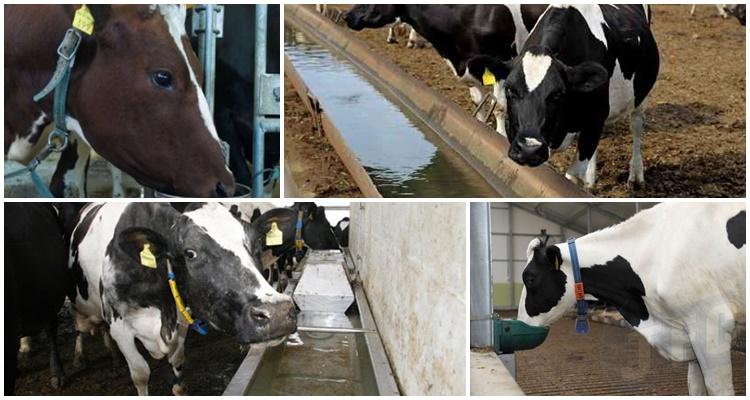
The cow should drink before each milking. An exception is a swollen and sore udder. To relieve inflammation, the udder is massaged, and the animal is milked more often. The first milking is performed one hour after calving.
Potential problems and solutions
Burenka is able to control the amount of liquid she drinks herself in the presence of thirst. For this, water must be freely available. If the cow begins to refuse water, this is a cause for concern.
Reasons for refusing water
The main reasons for not drinking water are as follows:
- inconvenient drinking bowl with poor access;
- too cold drink;
- the water is not fresh or has an unpleasant odor;
- stomach problems or a stuffy stomach.
If the water is fresh, clean, not cold, there is normal access to it, and the animal drinks little, then the digestive system is disturbed. If you have other symptoms, you should contact your veterinarian. A healthy cow that does not want to drink is smeared with herring on the lip. Experts recommend adding some salt to the feed. These methods help create thirst. If you follow all the recommendations, then the cow will regularly bring a lot of milk. And her health will not cause concern.



